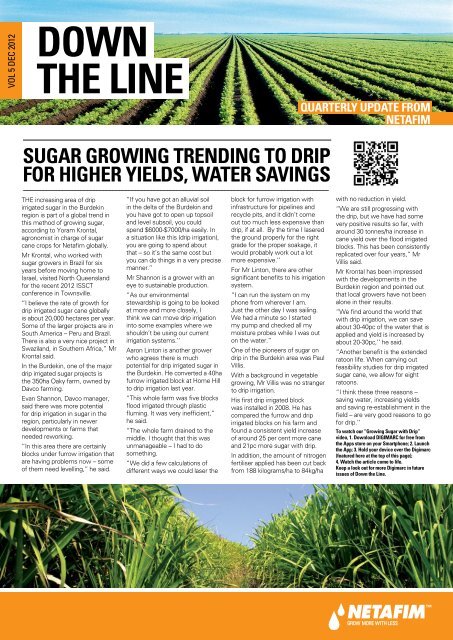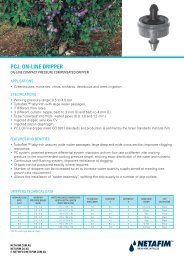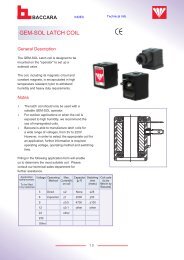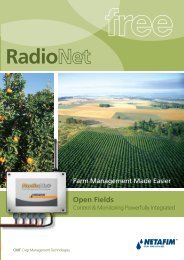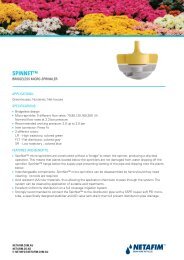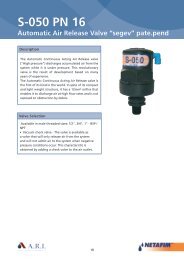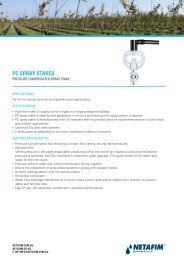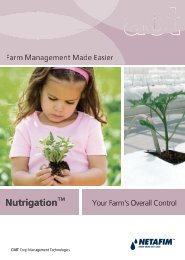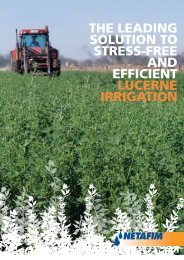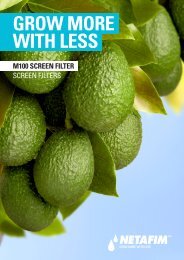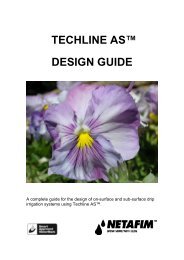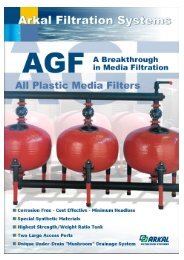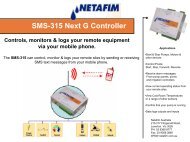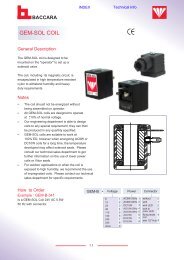DOWN THE LINE - Netafim
DOWN THE LINE - Netafim
DOWN THE LINE - Netafim
Create successful ePaper yourself
Turn your PDF publications into a flip-book with our unique Google optimized e-Paper software.
VOL 5 DEC 2012<strong>DOWN</strong><strong>THE</strong> <strong>LINE</strong>Sugar growing trending to dripfor higher yields, water savingsQUARTERLY UPDATE FROMNETAFIM<strong>THE</strong> increasing area of dripirrigated sugar in the Burdekinregion is part of a global trend inthis method of growing sugar,according to Yoram Krontal,agronomist in charge of sugarcane crops for <strong>Netafim</strong> globally.Mr Krontal, who worked withsugar growers in Brazil for sixyears before moving home toIsrael, visited North Queenslandfor the recent 2012 ISSCTconference in Townsville.“I believe the rate of growth fordrip irrigated sugar cane globallyis about 20,000 hectares per year.Some of the larger projects are inSouth America – Peru and Brazil.There is also a very nice project inSwaziland, in Southern Africa,” MrKrontal said.In the Burdekin, one of the majordrip irrigated sugar projects isthe 350ha Oaky farm, owned byDavco farming.Evan Shannon, Davco manager,said there was more potentialfor drip irrigation in sugar in theregion, particularly in newerdevelopments or farms thatneeded reworking.“In this area there are certainlyblocks under furrow irrigation thatare having problems now – someof them need levelling,’’ he said.“If you have got an alluvial soilin the delta of the Burdekin andyou have got to open up topsoiland level subsoil, you couldspend $6000-$7000/ha easily. Ina situation like this (drip irrigation),you are going to spend aboutthat – so it’s the same cost butyou can do things in a very precisemanner.’’Mr Shannon is a grower with aneye to sustainable production.“As our environmentalstewardship is going to be lookedat more and more closely, Ithink we can move drip irrigationinto some examples where weshouldn’t be using our currentirrigation systems.’’Aaron Linton is another growerwho agrees there is muchpotential for drip irrigated sugar inthe Burdekin. He converted a 40hafurrow irrigated block at Home Hillto drip irrigation last year.“This whole farm was five blocksflood irrigated through plasticfluming. It was very inefficient,”he said.“The whole farm drained to themiddle. I thought that this wasunmanageable – I had to dosomething.“We did a few calculations ofdifferent ways we could laser theblock for furrow irrigation withinfrastructure for pipelines andrecycle pits, and it didn’t comeout too much less expensive thandrip, if at all. By the time I laseredthe ground properly for the rightgrade for the proper soakage, itwould probably work out a lotmore expensive.’’For Mr Linton, there are othersignificant benefits to his irrigationsystem.“I can run the system on myphone from wherever I am.Just the other day I was sailing.We had a minute so I startedmy pump and checked all mymoisture probes while I was outon the water.”One of the pioneers of sugar ondrip in the Burdekin area was PaulVillis.With a background in vegetablegrowing, Mr Villis was no strangerto drip irrigation.His first drip irrigated blockwas installed in 2008. He hascompared the furrow and dripirrigated blocks on his farm andfound a consistent yield increaseof around 25 per cent more caneand 21pc more sugar with drip.In addition, the amount of nitrogenfertiliser applied has been cut backfrom 188 kilograms/ha to 84kg/hawith no reduction in yield.“We are still progressing withthe drip, but we have had somevery positive results so far, witharound 30 tonnes/ha increase incane yield over the flood irrigatedblocks. This has been consistentlyreplicated over four years,” MrVillis said.Mr Krontal has been impressedwith the developments in theBurdekin region and pointed outthat local growers have not beenalone in their results.“We find around the world thatwith drip irrigation, we can saveabout 30-40pc of the water that isapplied and yield is increased byabout 20-30pc,’’ he said.“Another benefit is the extendedratoon life. When carrying outfeasibility studies for drip irrigatedsugar cane, we allow for eightratoons.“I think these three reasons –saving water, increasing yieldsand saving re-establishment in thefield – are very good reasons to gofor drip.’’To watch our “Growing Sugar with Drip”video, 1. Download DIGIMARC for free fromthe Apps store on your Smartphone; 2. Launchthe App; 3. Hold your device over the Digimarc(featured here at the top of this page);4. Watch the article come to life.Keep a look out for more Digimarc in futureissues of Down the Line.
Gray Plantations upgrades toefficient, automated irrigation systemfor high density macadamiasAGRONOMY FOCUSFERTIGATINGMACADAMIASBY SAM BIRRELLNETAFIM AGRONOMISTESTABLISHMENT of a highdensity macadamia orchard anda desire to target irrigation to thetrees rather than also to the interrowsresulted in a preference foran automated dripperline systemover sprinklers at Gray Plantations’properties near Mackay inQueensland.The company expanded on itsholdings on the Northern Rivers ofNew South Wales seven years agoand is heading towards its firstproduction from 55,000 trees overtwo properties, Gray Plantationsand Red Eye Macadamia, nearMackay, where it also hasestablished a 100,000-treewholesale nursery.Mackay Manager GrahamWessling said trees at thecompany’s older NSW propertieswere at various spacings,including 11 metres wide by 6mand 10m wide by 3m, and whilethe industry average of 8m wideby 4m equated to 312 trees perhectare, the local properties wereon 6m wide by 2.5m, amountingto 667 trees/ha.The high density move promptedinvestment in <strong>Netafim</strong> dripperlineand controllers, which also wasencouraged by local irrigationdealers, for automated irrigationand fertigation of the orchards.<strong>Netafim</strong> ‘Typhoon’ dripperline,supplying 1.6 litres per hour at0.6m spacings, was installedalong the ground with the trees,while this year, in its fourth year,it is being upgraded to ‘Vineline’,which is clipped to the treesand is supplying 1.6L/hr at 0.5mspacings.“After three years the dripperlineis affected from being on theground and from the mulch anddingoes, and so we then hang andstaple the ‘Vineline’ over the tree,’’Graham said.“We have upgraded 20,000 treeson one property and 8000 on theother and we still have another20,000 that we will do this year.“The dripperline and ‘Vineline’ issimple and easy and you don’thave to add drippers.“In future though, we might stakethe trees and hang the irrigationup straight away.’’The irrigation and fertigation iscontrolled via <strong>Netafim</strong>’s NMC-64Climate controller and NMC-PROunit with SingleNet automationcontrol.Graham said he can remotelymonitor the system on his laptop.He said they were fertigating withnitrogen, potassium and someiron, but, due to the heavy claysoil type and high annual rainfall inthe area, this only occurred aboutonce a month to top up the profile.Annual soil and leaf testing isperformed to help design thefertigation program.Graham said a fertigation andtree expert visited the propertiesrecently and gave the system andprogram a big tick of approval.Graham Wessling inspects the<strong>Netafim</strong> Vineline that is clipped to theMacadamia trees.<strong>Netafim</strong>’s SingleNet automation unit at theGray Plantations property near Mackay.FertigationFertigation is the applicationof fertiliser with irrigation water.The process involves a fertilisersolution being injected into themain line and applied during anirrigation event.Fertigation provides theopportunity to apply a controlledquantity of fertiliser directly to theroot zone, minimising losses fromleaching and volatilisation.Well managed fertigation leadsto greater application efficiency.It is critical to manage fertigationcorrectly and there is an oftstatedmantra: “There is no goodfertigation without good irrigation”.Accurate irrigation scheduling andfrequency is the key to successfulfertigation.Soil & leaf analysisRegular soil and leaf analysiscan assist the development of afertigation program.General soil sample principles:• A sample is prepared from 25plugs across the field.• For perennial tree fruits, topsoilsamples are taken from the top15 centimetres (with the toplayer of crop / organic matterexcluded).• Deeper (60-90cm) soil samplescan also be taken for specificpurposes.• The soil “plugs” are mixed andsent to a laboratory for analysis.The soil analysis will show levelsof nutrients in the soil, such asN, P, K and secondary and traceelements. It will also show ratiosbetween certain elements andmeasures of salinity and sodicity.It is advised to take soil samplesevery two years.Plant tissue samples, commonlythe leaf, can also be taken foranalysis. Leaf sample analysisallows the opportunity to monitorplant nutritional status during theseason and, if necessary, this canbe corrected by nutrients appliedeither by fertigation or foliarapplication.An agronomist can comparethe analysis with benchmarkstandards and makerecommendations to correct anydeficiencies.ProgramsFertiliser programs are generallybased on the following factors:• Nutrient levels in the soil andleaf as identified by the analysis.• The stage of tree development.• Nutrient removal based on theprojected yield.Table 1 is an example of a fertiliserprogram based on nutrientremoval (with allowances madefor normal losses).The way to work out how muchof a particular fertiliser is requireduses the following formula:DIAGRAM 1 DIAGRAM 2TABLE 1 (From ‘Mac Growing Guide’, DEEDI, Qld 2004)Crop Yield (t/Ha)Requirements for full replacement of lost nutrients (kg/Ha)NISat 10% m.c.Nitrogen Phosphorus Potassium Calcium Magnesium2 27 2.5 22 1 24 55 5 44 2 46 82 7.5 66 3 6Nutrient rate (units/ha) x 100Analysis (%) of nutrient in productused = fertiliser rateIf the fertiliser being used overthe season was Urea AmmoniumNitrate (UAN) and assuming theN required is for a 4-tonne perhectare crop, then the fertiliserrequirement would be calculatedas such:55 (units of N required) x 10042.5(% of N in UAN fertiliser) = 129.4litres/ha of UANOf course, fertiliser may berequired at different rates atdifferent times during the seasonand there are blends that willprovide different amounts of P andK relative to N.In these cases, it is best to basethe fertiliser application on theN required and get the P and Kas close to the requirement aspossible. This is because the P andK is less susceptible to leaching orvolatilisation than the N.In most cases, fertiliser applicationwill be more efficient if split intosmaller treatments during thegrowing season.Fertigation methodsHydraulic pumpsHydraulic pumps use a pistonthat is driven by the pressureof the water running throughit. A hydraulic pump, such as aDosatron, can give an accuratedose of solution into a flow ofwater and can be set at a widerange of ratios. See Diagram 1.Venturi injectorA venturi injector uses no movingparts and creates a vacuumwhereby a fertiliser solution canbe sucked into the main irrigationwater flow.A fertiliser meter connected to anirrigation controller can regulatethe flow of the solution. Often abooster pump is used to createthe pressure differential thatmakes the venturi work. SeeDiagram 2.References: Macadamia Growers Handbook,DEEDI, Qld (2004); http://era.deedi.qld.gov.au/1964/5/mac-growing_guide_Part5.pdf4<strong>Netafim</strong> Agronomist Peter Henry pictureddiscussing plant nutrition with GrayPlantations Mackay Manager GrahamWessling and Ben Hayward.5
New technologiessimplify WAnursery operation<strong>Netafim</strong>’s Paul Officer and Patrick Johnson (right) and The Seedling Factory’s General ManagerBen Funnekotter inspect <strong>Netafim</strong>’s flow regulated ‘SuperNet’ micro sprinklers, which haveprovided excellent uniformity and efficiency.Patrick and Paul with Ben, overlooking eucalypts at its new Oakford nursery.6WHILE the expansion of TheSeedling Factory’s nurseryoperation south of Perth inWestern Australia has introduceda range of new-age technologies,General Manager BenFunnekotter says the company isactually simplifying its productionsystem.The Seedling Factory, which ispart of Environmental Industriesand the Winterbourn Group ofCompanies, commenced at theformer Sumich Group, 5-hectare(12-acre) nursery site at HopeValley in 2000. It continuedsupplying vegetable seedlingtransplants to local growers,while today it also offers flowerand forestry transplants to theWA industry.The nursery produces 50 millionseedlings per annum and this isset to increase significantly asit progressively relocates andgrows at a new 17.5ha (43ac) siteat Oakford.Ben said the companyrecognised the productionincrease would require “aquantum change of mindset’’for nursery management andproduction and so it visitednurseries around the world toassist its latest move.“We saw some of the biggestnurseries in the world and wewere surprised how simple somewere,’’ he said.The company plans to establishindividual tunnels wherenecessary and use naturalventilation at Oakford, comparedwith an old, complicated systemat Hope Valley involving climatecontrol, mechanical ventilation,misters and other systems.The nursery also had moved fromusing butterfly sprinklers to boomwatering systems and, morerecently, to <strong>Netafim</strong>’s sprinklersystems, which Ben said offeredamazing evenness of applicationand had not been touched sincetheir installation.“Booms irrigate evenly but theyhave maintenance issues andtake time to go over sections.Solenoids just open and close,’’he said.“With booms, if there is a frostyou cannot irrigate quick enough.By the time the booms go downand back, the seedlings arefrozen. With the sprinklers, youcan turn them on and off in fiveminute intervals and prevent theice forming.“So we saw the sprinklers werean option and we have beenblown away with the evennessof the <strong>Netafim</strong> sprinklers. Somehave been there for five tosix years and we have neverreplaced them.’’At the new Oakford property,where native tree seedlings havebeen in production since late lastyear, <strong>Netafim</strong>’s flow regulated‘SuperNet’ micro sprinklershave been installed and haveprovided excellent uniformity andefficiency.“the companyrecognised theproductionincrease wouldrequire“a quantumchange ofmindset’’for nurserymanagement andproduction”“They have been phenomenal,which you can see in theevenness of the plants,’’ Ben said.The SuperNet sprinklers cater forflow rates ranging from 20-110litres per hour at pressures from1.5-4 bars.At the Hope Valley nursery,<strong>Netafim</strong>’s SpinNet and GyroNetsprinklers also have been used,the latter with anti-drain valves tohelp optimise the irrigation, andBen said there had never beena failure because high qualitysolenoids had been installed.The irrigation system at theOakford development drawsfrom five bores and featuresautomatic irrigation andfertigation control as well asback-up pumps and powerfacilities via a 200kVA generator.All bore water is filtered beforebeing placed in a large storagetank. It is pumped from this tankwith pressure controlled pumpsthrough a bank of <strong>Netafim</strong> SpinKlin filters to polish the waterbefore nutrients are added and itis sent to the field.“At the Hope Valley property, ifwe had a power cut and ran outof water on the weekend, wewould have to wait for the tank tofill and then it takes 48 minutesfor the booms to go over theseedlings, which can be too late,’’Ben said.The irrigation at Oakford isautomatically controlled by<strong>Netafim</strong>’s advanced Netajetsystem, which also comes withEC and pH control. The Netajetis an all-in-one control andinjection system for total nutrientapplication control.Ben said the Netajet system wasa great irrigation controller.“If you can control flow rates andpressures, then sprinklers dowhat you want them to do. TheNetajet monitors the individualvalves and the flow rates.’’The Netajet connects to thefield using the SingleNet twowire system. This providesflexibility to add valves anywhereon the mainline network andgrow the system as required.The system uses the AquanetDC 50-millimetre valve withthe pressure regulating moduleacross the development.Ben said a range of fertiliserrecipes had been logged into theNetajet, incorporating the useof calcium nitrate, potassiumsulphate, Poly-Feed, MAP andother products.Excellent servicing towards TheSeedling Factory’s full irrigationsystem from <strong>Netafim</strong> CropManagement Technologies (CMT)Manager John Witherspoon wascritical in the Netajet investment.Ben said John was called andarrived at the property to fix aproblem with a separate partof their irrigation all within twohours, which was vital for thehighly time-pressured seedlingproduction system.“The service was amazing andJohn has helped us a lot. It is partof the reason we already havethe space for another controllerto go in as we grow,’’ he said.Patrick, Paul and Ben at The Seedling Factory’s Hope Valley property where <strong>Netafim</strong>’s SpinNet andGyroNet sprinklers have been used, the latter with anti-drain valves to help optimise the irrigation.Ben takes Patrick and Paul through The Seedling Factory’s set up on the <strong>Netafim</strong> advancedNetajet system, which also comes with EC and pH control. The Netajet is an all-in-one control andinjection system for total nutrient application control.PRODUCTHIGHLIGHTNETAJET 3G CONTROLLERNETAFIM’s NetaJet 3G controlleroptimises water and fertiliserutilisation for specific crops andsoil types.Available in three models, theInline, Bypass and High-Flow, theNetaJet range is suitable for openfield and greenhouse applications.Features and benefits:• Inline: 5 to 20m3/h, 3 to 6 Bar.• Bypass: 20 to 120m3/h,3 to 6 Bar.• High-Flow: 80 to 400m3/h,3 to 6 Bar.• Standard with three dosingchannels.• Expandable to five dosingchannels.• Automatic dosing channelbypass.• Options for acid dosing channel.• Single EC and pH probesand control.• Option for dual EC and pHfor greenhouses.• Machine controller by theNMC-Pro.• Up to 256 irrigation valves.• Can be interfaced with eitherthe <strong>Netafim</strong> SingleNet orRadioNet remote RTUs.• On-board Grundfos Boosterpump with built-in pumpprotection and overloads.• Each dosing channel includes aflow regulating valve and visualflow meter.• Pressure-reducing valve on theinlet and pressure sustainingvalve on the outlet to ensuresmooth dosing.• Hydro-mixing chamber to blendthe product before injection.• Each channel can be fitted withan optional fertiliser meter.• Fertigation program – eightmethods, Time (bulk, time/time,time/quantity), Quantity (bulk,quantity/quantity, quantity/time),Ratio (1/1000).• Filter flushing – By Time triggerand/or by Pressure Differentialswitch (DP).• Multiple category logbookproviding sensor history andevent history.• Alarms – error detection for theirrigation system, water supply,fertigation system, filters andcontroller hardware.• System failure battery back-upfor software configuration, usersettings and data memory.7
DEALER BENEFITSIN WA MOVENew customer service teamhits ground runningDEALERS and customers phoninginto <strong>Netafim</strong>’s customer serviceand technical support team atthe company’s head office inMelbourne will have heard anumber of new voices in recentmonths.<strong>Netafim</strong> has welcomed three staffto its customer service desk thisyear that range from experienced,young and new to the industry.Pieter Clarke, who joined thebusiness in July, has worked indifferent sectors of the industryover 27 years.Pieter spent 17 years with RainBird in area sales managementand technical support at a numberof locations including Adelaide;Perth; Melbourne, which includedresponsibility for Victoria and NewZealand; Kuala Lumpur, where hesupported the South East Asiaregion and into China; and Dubai,where he serviced the MiddleEast.He also chalked-up close to adecade with Toro split betweenAustralia and Dubai.8With Rain Bird predominantlycatering to the turf sector andToro involved primarily in golf andturf maintenance, Pieter said hewas now enjoying the strongeragricultural focus in his new rolewith <strong>Netafim</strong>.He said the company also offereda wider product range, particularlyin the area of filtration and watermetering.Corey Clifford joined the teamearlier this year after relocating toMelbourne from Adelaide, wherehe had spent two years with ThinkWater, most recently in sales anddesign.Born and bred in South Australia’sRiverland region, Corey also hashad four years experience with anirrigation dealership at Barmerathat serviced both the landscapeand agricultural sectors.He said the new position with<strong>Netafim</strong> was a change fromservicing customers to largelysupporting dealers and he wasembracing the challenge.<strong>Netafim</strong>’s team in Western Australia recently chalked up 12 monthsat its new base in Bibra Lake, south of Perth, after relocating fromMalaga in the city’s east. While offering a similar capacity to Malaga,the new premises has allowed important opportunities for salesseminars and training with dealer and installation staff. Pictured atthe Bibra Lake office and warehouse is Mark Van Welie and PiotrLuszcek, warehouse distribution and sales, with area sales managersPaul Officer and Patrick Johnson. Patrick also works in technicalservices. Other staff in WA include Crop Management Technologies(CMT) Manager John Witherspoon and Southern WA Area SalesManager Wayne Jennings, who are located in Bunbury. The WAbusiness supplies dealers and assists specialty orders across theState. Major dealers include Total Eden, Water Dynamics, WaterShed, Western Irrigation and Elliotts Irrigation.“I am thoroughly enjoying it. Nophone call or order is the sameand it is great to give dealersadvice on the best things they cando to assist their clients,’’ Coreysaid.The third member of the teamwho is new to the industry isAnna Suric, who also joined thecompany in July.Anna has spent 12 years in acustomer service role with anoptical store in Melbourne’s CBD.This included managing orders andoperating a mail order business aswell as a website ordering service.Anna said her early stageswith <strong>Netafim</strong>, which mainlyinvolved entering sales, had beenextremely busy and she waskeen to build her knowledge onthe company’s large range ofproducts.She also is looking forward togetting into the field in futureto view <strong>Netafim</strong>’s systems inoperation.Pieter ClarkeCorey CliffordAnna SuricRegister product purchases onlinefor chance to win a LeathermanPURCHASERS of<strong>Netafim</strong> equipmentcan now go inthe running fora Leathermanevery month byregistering theirproducts online.TECH TIPPRESSURE REDUCING VALVESCurrent optionNETAFIM’s current pressurereducing valves come supplied,as standard, with a three-way tap.These taps allow you to either(O) open the valve manually, (C)close manually or (A) operateautomatically.Potential hazards withmanual operationBy actuating a valve manuallyto open, operators will overridethe pressure reducing functionof the valve and open thedownstream to full pressure. Thiscan be detrimental to the system’sdripline sprinklers and associatedSTEP 1First locate and remove the Tefen fitting andtube from the open port.<strong>Netafim</strong> has commenced the newregistration process in an effort toimprove service and support todealers and users.Customers can relax in theknowledge that their newlypurchased <strong>Netafim</strong> equipmentis flagged with the company andcovered by product warranty.To enterUsers can head to the <strong>Netafim</strong>website to complete an onlineregistration form. The ‘Productfittings, which can lead to failuresin the future.SolutionBy removing the Tefen fitting andinstalling a plug in the open port,operators eliminate the risk ofdamage caused by inadvertentlyopening the valve and bypassingthe pressure control circuit. Seesteps 1 to 4 below.Facts about flushing submains with pressure reducingvalvesIn most cases, it is believedthat a valve has to be openedmanually to flush out sub mains,but this is not always the case.STEP 2Install a 1/8 BSP plug 71000-032350 into theopen port.Registration’ tab can be foundon the <strong>Netafim</strong> home page orclick here.Once the form is submitted,customers go directly into themonthly draw.<strong>Netafim</strong> would like to congratulateTasmanian onion growerStuart Coles, Hagley,on winning th e October draw.Stuart purchased his product fromIrrigation Tasmania in Somerset.In most instances where a fixedduty pump is installed and thedownstream flow demand isgreater than what is required tomaintain the set pressure, thepilot will open the valve fully to tryand achieve this setting.If it is unable to reach this point, itwill remain fully open (exactly thesame as opening manually).The difference is once the submain is shut-off and the valve’spilot senses the rising pressure,it will automatically adjust theflow to maintain the set operatingpressure, which will eliminate therisk of damage associated withhigh pressure spikes etc.STEP 3Under system pressure, turn the tap lever fromthe auto position to open. Check that the plugis sealing then return the lever back to auto.with peter sullivanvalve managerUsually, with the increased flowduring flushing, the velocities areenough to achieve successfulpurging of sub mains and, for thisreason, it may be worth checkingthis out before opting for manualoperation of valves.TipIt is not usually necessary to usethread sealant or PTFE tape.Just screw the plug in tightenough to seal to aid easeof removal, should the needbe required to open the valvemanually in the future.STEP 4Job done!!9


